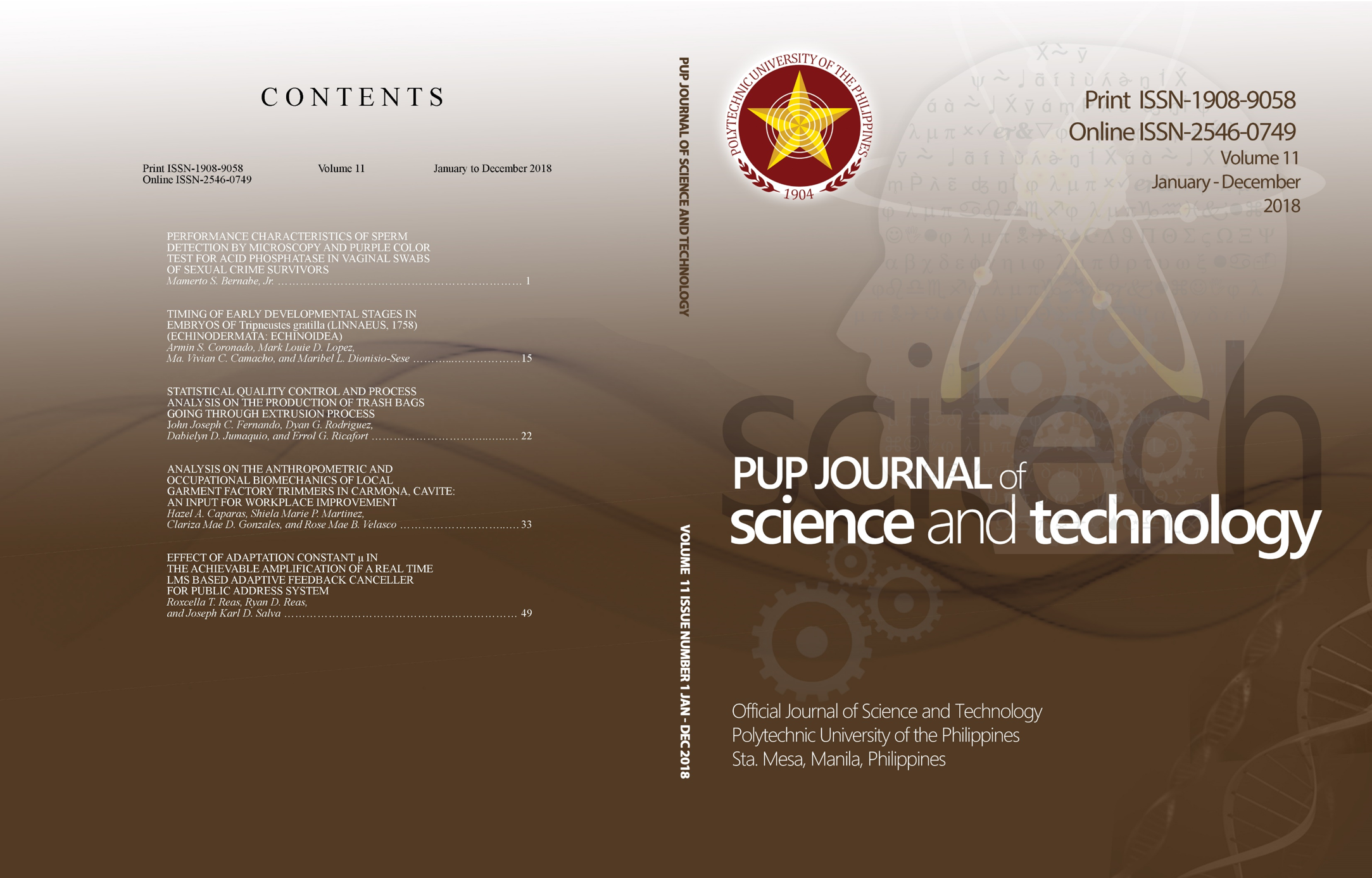Timing of Early Developmental Stages in Embyos of Tripneustes gratilla (Linnaeus, 1758) (Echinodermata: Echinoidea)
Main Article Content
Abstract
Sea urchin is one of the most important subjects in developmental biology studies due to its rapid and simple development. Timing for its development is a key component for most experiments. However, available data often vary due to the effect of temperature and other external factors. With this, standardization on the timing of the early developmental stages in embryos of Tripneustes gratilla was conducted in this study. Induced spawning and in-vitro fertilization were done on the collected sea urchins. Morphology of the embryo and timing for each developmental stage including early cleavage stages, morula, and blastula were studied. Sea urchin embryos started its development at 2 minutes after fertilization and reached blastula stage after 6 hours. Developmental stages of T. gratilla embryos exhibited embryological distinction from one another and tend to develop rapidly after fertilization making it an appropriate model organism for biological researches.
Downloads
Article Details
Section

This work is licensed under a Creative Commons Attribution-NonCommercial 4.0 International License.
How to Cite
References
Adelson, D. L. & Humphreys, T. (1988). Sea urchin morphogenesis and cell-hyalin
adhesion are perturbed by a monoclonal antibody specific for hyaline. Development,
104(3), 391-402.
Briggs, E. & Wessel, G. M. (2006). In the beginning: animal fertilization and sea urchin
development. Dev Biol, 300(1), 15-26.
Capinpin, E. C. (2015). Growth and survival of sea urchin (Tripneustes gratilla) fed
different brown algae in aquaria. Int J Fauna Biol Stud, 2(3), 56-60.
Costa-Lotufo, L. V., Ferreira, M. A. D., Lemos, T. L. G., Pessoa, O. D. L., Viana, G. S.
B., & Cunha, G. M. A. (2002). Toxicity to sea urchin egg development of the
quinone fraction obtained from Auxemma oncocalyx. Braz J Med Biol Res, 35(8),
927-930.
Ernst, S. G. (1997). A century of sea urchin development. Am Zool, 37(3), 250-259.
Ghorani, V., Mortazavi, M. S., Mohammadi, E., Sadripour, E., Soltani, M., Mahdavi
Shahri, N., & Ghassemzadeh, F. (2012). Development of developmental stages in the
sea urchin. Echinometra mathaei. Iran J Fish Sci, 11(2), 294-304.
Junio-Meñez, M. A., Macawaris, N. D., & Bangi, H. G. P. (1998). Community-based sea
urchin (Tripneustes gratilla) grow-out culture as a resource management tool. Can
Spec Publ Fish Aquat Sci, 125, 393-399.
King, C. K. & Riddle, M. L. (2001). Effects of metal contaminants on the development of
the common Antarctic sea urchin Strechinus neumayeri and comparisons of
sensitivity with tropical and temperate echinoids. Mar Ecol-Prog Ser, 215, 143-154.
Kominami, T. & Takata, H. (2003). Timing of early developmental events in embryos of
sea urchin Echinometra mathaei. Zool Sci, 20(5), 617-626.
Levitan, D. R., Sewell, M. A., & Chia, F. S. (1991). Kinetics of fertilization in the sea
urchin Strongylocentrotus franciscanus: interaction of gamete dilution, age and
contact time. Biol Bull, 181(3), 371-378.
Levitan, D. R., TerHorst, C. P., & Fogarty, N. D. (2007). The risk of polyspermy in three
congeneric sea urchins and its implications for genetic incompatibility and
reproductive isolation. Evolution, 61(8), 2007-2014.
Manuel, J. I. J., Prado, V. V., Tepait, E. V., Estacio, R. M., Galvez, G. N., & Rivera, R.
N. (2013). Growth performance of the sea urchin, Tripneustes gratilla in cages under
La Union condition, Philippines. Int J Sci Res, 5(1), 195-202.
Masuda, M. & Sato, H. (1984). Asynchronization of cell divisions concurrently related
with ciliogenesis in sea urchin blastulae. Dev Growth Differ, 26(3), 281-294.
Mazur, J. E. & Miller, J. W. (1971). A description of the complete metamorphosis of the
sea urchin Lytechinus variegatus cultured in synthetic sea water. 1971. Ohio J Sci,
71, 30-36.
Moulin, L., Catarino, A. I., Claessens, T., & Dubois, V. (2011). Effects of seawater
acidification on early development of the intertidal sea urchin Paracentrotus lividus
(Lamarck, 1816). Mar Pollut Bull, 62(1), 48-54.
Pinto, L. M. (2009). Testing evolutionary developmental hypothesis with sea urchins: a
study of plasticity and homology. MSc Thesis. McMaster University, Hamilton,
Ontario, Canada. Russo, R., Bonaventura, R., Zito, F., Schröder, H. C., Müller, I., Muller, W. E., &
Matranga, V. (2003). Stress to cadmium monitored by metallothionein gene
induction in Paracentrotus. Cell Stress Chaperones, 8(3), 232-241.
Schatten, G. & Hülser, D. (1983). Timing the early events during sea urchin fertilization.
Dev Biol, 100(1), 244-248.
Semenova, M. N., Kiselyov, A., & Semenov, V. V. (2006). Sea urchin embryo as model
organism for the rapid functional screening of tubulin modulators. BioTechniques,
40(6), 765-774.
Shen, S. S. & Bugart, L. J. (1985). Intracellular sodium activity in the sea urchin egg
during fertilization. J Cell Biol, 101(2), 420-426.
Shimek, R. L. (2018). The toxicity of some freshly mixed artificial sea water: a bad
beginning for a reef aquarium. Reefkeeping: an online magazine for the marine
aquarist, Available at http://reefkeeping.com/issues/2003-03/rs/feature/index.php,
accessed August 2018.
Talaue-McManus, L. & Kesner, K. P. N. (1993, June). Valuation of a Philippine
municipal sea urchin fishery and implications of its collapse, 229-239. In Juinio-
Meñez, M. A. & Newkirk, G. F. Philippine Coastal Resources Under Stress. Selected
papers from the Fourth Annual Common Property Conference, Manila, Philippines.

